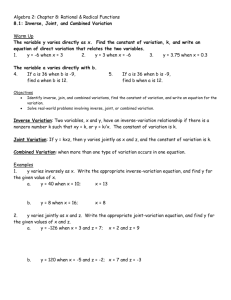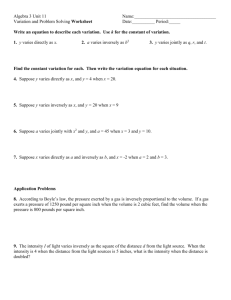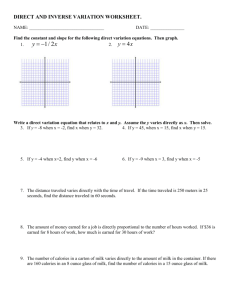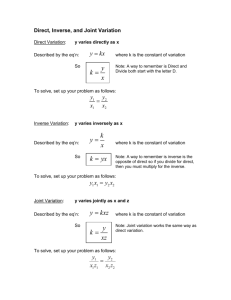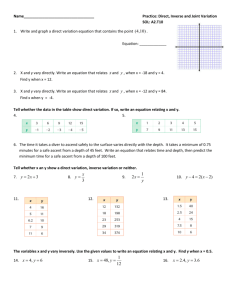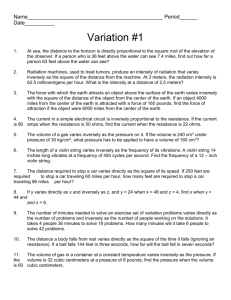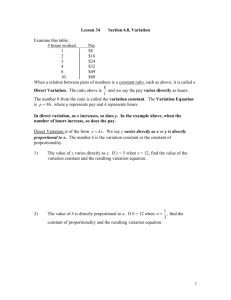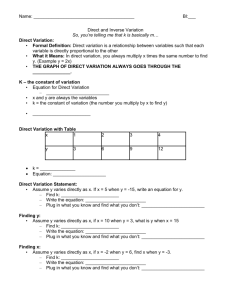Section 9.1 Variation
advertisement
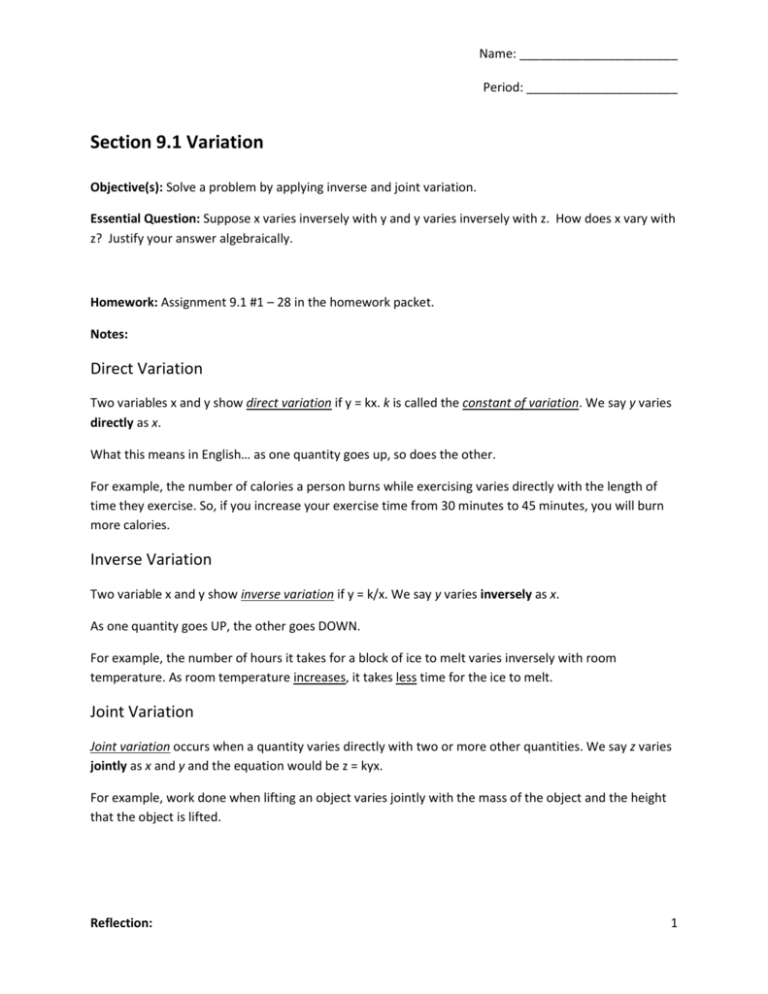
Name: _______________________ Period: ______________________ Section 9.1 Variation Objective(s): Solve a problem by applying inverse and joint variation. Essential Question: Suppose x varies inversely with y and y varies inversely with z. How does x vary with z? Justify your answer algebraically. Homework: Assignment 9.1 #1 – 28 in the homework packet. Notes: Direct Variation Two variables x and y show direct variation if y = kx. k is called the constant of variation. We say y varies directly as x. What this means in English… as one quantity goes up, so does the other. For example, the number of calories a person burns while exercising varies directly with the length of time they exercise. So, if you increase your exercise time from 30 minutes to 45 minutes, you will burn more calories. Inverse Variation Two variable x and y show inverse variation if y = k/x. We say y varies inversely as x. As one quantity goes UP, the other goes DOWN. For example, the number of hours it takes for a block of ice to melt varies inversely with room temperature. As room temperature increases, it takes less time for the ice to melt. Joint Variation Joint variation occurs when a quantity varies directly with two or more other quantities. We say z varies jointly as x and y and the equation would be z = kyx. For example, work done when lifting an object varies jointly with the mass of the object and the height that the object is lifted. Reflection: 1 Translating Problems into an Equation: 3 types varies directly as = k varies jointly as = k and varies inversely as = k Write an equation to describe the variation. Example 1: w varies directly as v Example 2: r varies directly as t Example 3: m varies inversely as n Example 4: t varies inversely as s Example 5: x varies jointly as y and z Example 6: w varies jointly as p and q Example 7: J varies directly as M and inversely as N Example 8: i varies inversely as the square of d Example 9: D varies directly with the square root of L and inversely with the square of T Reflection: 2 Example 10: the handle. The force F needed to loosen a bolt with a wrench varies inversely with the length l of Example 11: The gravitational force F between two objects varies jointly with their masses m1 and m2 and inversely with the square of the distance d between the two objects. Steps for Variation Problems 1. 2. 3. 4. 5. 6. Write an equation to describe the variation. Substitute the first set of numbers into the equation. Solve for k. Replace k in your equation with the number you just found. Substitute the second set of numbers into the equation (the one where k is a number). Solve for whatever variable is asked for. Solve. Find k and then the answer. Example 12: If r varies directly with q, and r = 56 when q = 7, find r when q is 6. Variation equation: ___________________ r = ________ q = ________ (the FIRST q) Substitute r and q into variation equation: ___________________ and solve for k. k = ________ Use the variation equation and substitute with k and the new variables: ____________________ q = ________ (the SECOND q) Solve for r. r = ________ Example 13: If n varies directly with m, and n = 72 when m = 8, find n when m is 5. Variation equation: ______________________ n = ________ Reflection: 3 Example 14: If y varies directly as x and inversely as z, and y = 1 when x = 9 and z = 18, find y when x is 2 and z is 3. Variation equation: ______________________ y = ________ Example 15: 3. If w varies jointly as p2 and r, and w = 81 when p = 3 and r = 3, find w when p is 2 and r is Variation equation: ______________________ w = ________ Example 16: The intensity I (in watts per square meter) of a sound varies inversely with the square of the distance d (in meters) from the sounds source. At a distance of 1 meter from the stage, the intensity of the sound at a rock concert is about 10 watts per square meter. If you are sitting 15 meters back from the stage, what is the intensity of the sound you hear? Reflection: 4 Sample CCSD Common Exam Practice Question(s): 1. The value of s varies jointly with m and p. If s = 10 when m = 3 and p = 4, what is the value of s when m = 7 and p = 2? A. 47 6 B. 81 5 C. 49 5 D. 35 3 Reflection: 5 Section 9.2 Simplifying Rational Functions Objective(s): Simplify rational expressions. Essential Question: What is the formula for factoring sum/difference of two cubes? Homework: Assignment 9.2 #29 – 41 in the homework packet. Notes: Simplifying Rational Expressions 1. Factor numerator and denominator 2. Cancel common FACTORS (not terms – leave anything INSIDE the parentheses ALONE) Simplify the rational expression. Example 1: ( x 1)( x 8) ( x 2)( x 1) Example 3: 20 x 2 12 x 20 x Example 2: ( x 3)( x 5) ( x 5)( x 3) Hint: What is the GCF? Do NOT cancel 20x on top with the 20x on the bottom!!!! Example 4: Reflection: 5 x 30 4 x 24 Example 5: 12 x 12 y x y 6 Example 6: 9 x 2 27 x3 5 x 15 x 2 Example 7: 2x 3 10 x 19 x 6 Example 8: x2 6 x 8 x 2 10 x 16 Example 9: 3x3 27 x x3 2 x 2 15 x Example 10: x3 2 x 2 8 x 2 x3 32 x Reflection: 2 7 Section 9.3 Multiplying and Dividing Rational Functions Objective(s): Multiply and divide rational expressions. Essential Question: What is the formula for factoring sum/difference of two cubes? Homework: Assignment 9.3 #42 – 54 in the homework packet. Notes: Multiplying Fractions 1. 2. 3. 4. 5. Factor numerator and denominator Cancel common FACTORS Multiply numerators Multiply denominators Leave in FACTORED form (do not distribute/FOIL) Example 11: 2 5 3 2 Example 12: 2 x 2 15 5 x3 Example 14: 40 xy 2 8x 80 x 2 100 5x 2 y 2 Reflection: Example 13: 8x 8 7 x2 x 9x 9 8 Example 15: x2 5x 6 x2 5x x 2 7 x 10 x 2 7 x 12 Dividing Fractions 1. 2. 3. 4. 5. 6. Flip the SECOND fraction and change the sign to multiply Factor numerator and denominator Cancel common FACTORS Multiply numerators Multiply denominators Leave in FACTORED form (do not distribute/FOIL) Example 16: 2 8 9 3 Example 18: x 2 14 x 49 x 2 49 x7 7 x 49 Reflection: Example 17: 2 x 2 x3 3 12 9 x 2 12 x 35 x2 7 x x 2 14 x 45 x 2 18 x 81 Example 19: Sample CCSD Common Exam Practice Question(s): 1. Simplify the expression: x2 3 x 4 x2 4 x 2 x 2 16 x x2 A. 1 B. 1 x4 C. x2 x4 D. x x2 Reflection: 10 Section 9.4 Solving Rational Equations Objective(s): Solve equations involving rational expressions. Essential Question: When is cross-multiplying an appropriate method for solving a rational equation? Homework: Assignment 9.4 #55 – 67 in the homework packet. Notes: Finding the Least Common Multiple 1. Factor the expression (if it is a binomial or trinomial) 2. List each factor to the HIGHEST exponent Find the least common multiple. Example 1: 2 5 Example 2: 4 6 LCM = _________________ LCM = _________________ Example 3: Example 4: x 4x LCM = _________________ Example 5: x2 – 4 LCM = _________________ Reflection: 6 30 5x LCM = _________________ x+2 Example 6: x2 + 5x x2 – 25 LCM = _________________ 11 Solving Rational Expressions 1. Find the LCM using all of the denominators. 2. Multiply every NUMERATOR by the LCM. 3. Cancel each denominator with your LCM. (If you still have something in the denominator, then you did something wrong.) 4. Solve for x. Solve the equation. Example 7: x x 2 3 7 LCM = _________________ Example 8: 3 x 1 8 2x x x LCM = _________________ Example 9: 1 7 3 4x 8 x LCM = _________________ Reflection: 12 Example 10: 1 1 3 3x 5 x 15 LCM = _________________ Example 11: 3x 1 3 x 4 LCM = _________________ Example 12: 5 7 x 36 x 6 LCM = _________________ Example 13: 2 6 x 9x x 9 LCM = _________________ Reflection: 2 2 13 John can paint a birdhouse in 2 hours and Kathy can complete the same job in 3 hours. How long would it take for them to complete the job if they were working together? Why is the answer NOT 5 hours????? “Work" problems involve situations such as two people working together to paint a house. You are usually told how long each person takes to paint a similarly-sized house, and you are asked how long it will take the two of them to paint the house when they work together. x x 1 job time for person 1 time for person 2 Example 14: John can paint a birdhouse in 2 hours and Kathy can complete the same job in 3 hours. How long would it take for them to complete the job if they were working together? Example 15: Maria can sew a quilt in 3 hours and Sam can sew the same quilt in 6 hours. If Maria and Sam work together on the job and the cost of labor is $30 per hour, what should the labor estimate be? Reflection: 14 Sample CCSD Common Exam Practice Question(s): 1. 2. Solve 7 1 1 . 3n 4n A. n 1 12 B. n 2 49 C. n 1 42 D. n 1 84 Solve the rational equation for y: 5 5 y 10 5 2 y 5 y 8 y 15 y 3 A. y = –2 B. y=0 C. y=2 D. y = 4 3. The equivalent resistance R of two resistors in parallel, with resistances r1 and r2 , is given by the formula: 1 1 1 R r1 r2 If r1 has twice the resistance of r2 , what is the value of r2 if the equivalent resistance is 30 ohms? A. 15 ohms B. 30 ohms C. 45 ohms D. 90 ohms Reflection: 15
